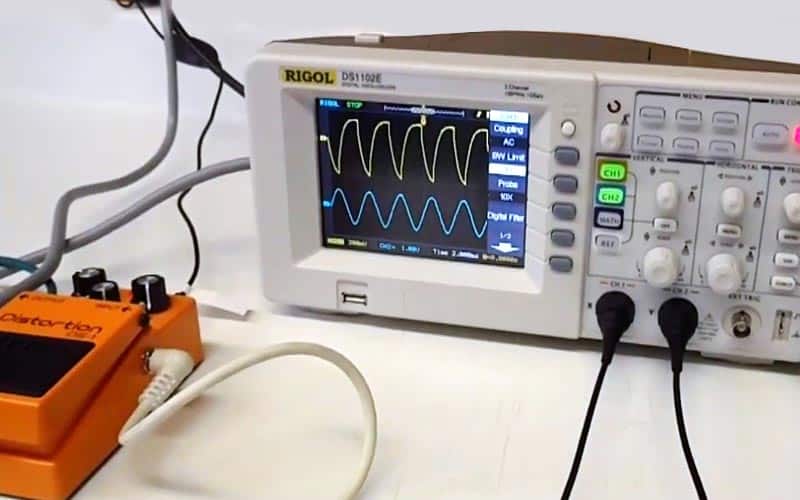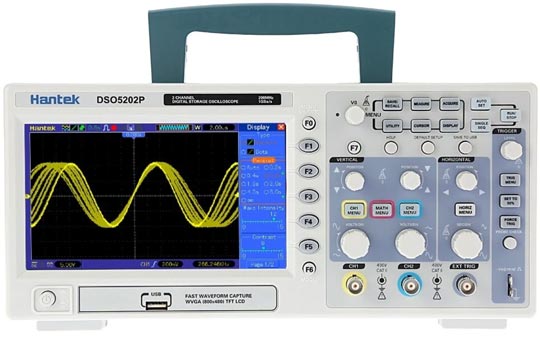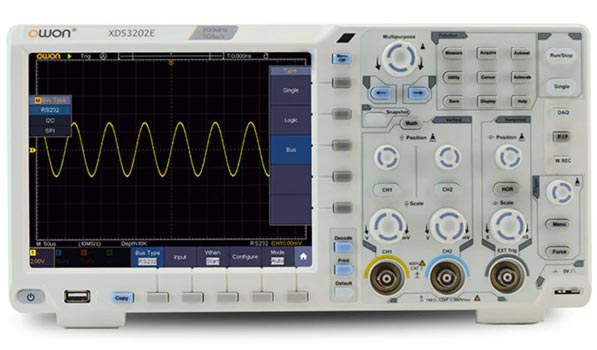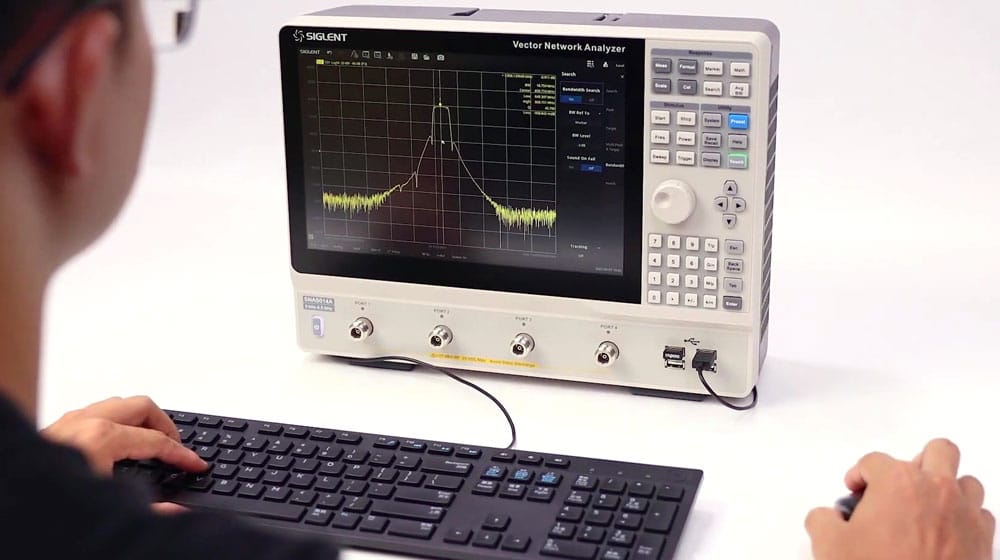
Whether you’re an experienced guitarist or a beginner, it’s important to have the best oscilloscope for guitar pedal. An oscilloscope is a device that allows you to measure and visualize the frequency of sound waves. With this tool, you can accurately analyze your soundscapes signals and make precise adjustments to your guitar pedals.
The best oscilloscope for guitar pedal is one that can accurately measure signal frequency, amplitude and shape. It should also have a wide range of measurement capabilities so you can see the full spectrum of your guitar tone. Additionally, it is important to consider the design and ease-of-use when purchasing an oscilloscope.
What are the requirements for the Best Oscilloscope for Guitar Pedal?
When working with a guitar pedal you will be dealing with a 10 kHz square wave, and this is our starting point for choosing an oscilloscope.
In order to look at square waves on an oscilloscope, you need a sampling rate that is at least double the frequency of the wave. For example, if you want to look at a 10 kHz square wave, you need a sampling rate of at least 20 MS/sec. This is because the oscilloscope takes samples at regular intervals, and if the interval is too long, the wave will appear distorted.
Fortunately, most oscilloscopes have a default sampling rate of 50 MS/sec, so they should be able to handle most audio signals without any trouble. However, if you are using a guitar pedal or other high-frequency device, you may need an oscilloscope with a higher sampling rate in order to get an accurate representation of the signal.
How to choose Oscilloscope for guitar pedal or amp?

When it comes to selecting the best oscilloscope for your guitar pedal, there are several factors to consider. First and foremost, you want an oscilloscope with a high degree of accuracy. Look for features such as automatic calibration, adjustable timebase, and adjustable resolution. Additionally, many oscilloscopes come with an intuitive user interface that makes monitoring sound signals easier.
Finally, check if the oscilloscope is compatible with different types of guitar pedals and other devices in case you work with other gadgets. Some models may only be able to handle one type of pedal, while others are designed for multiple. Additionally, it’s best to opt for an oscilloscope that has multiple inputs so you can monitor a variety of sounds at once.
Best Oscilloscope for Guitar Pedal – Waht to choose?
If you only need an oscilloscope to work with a simple guitar pedal, you can try an old second-hand oscilloscope, since even the old tektronix oscilloscope will work with a frequency of 10 MHz, but since we are keeping up with the times, we will consider the modern models of the main manufacturers.
Buying one of these oscilloscopes would be a good investment, because, first of all, these models will provide the full range of functions for working with electronics, have excellent quality, ease of use, and most importantly, excellent sampling rate, which has gone far from what the old oscilloscopes could do.
Recommendations for an Oscilloscope for pedal and amp work include: Hantek DSO5102P, Rigol DS1054Z and Owon XDS3202A-V. These models are known for their high accuracy and range of features that make monitoring sound signals easier.

Hantek DSO5202P Digital Oscilloscope
- 200MHz bandwidths,1GSa/s Real Time sample rate
- Large (7.0-inch) color display,WVGA(800×480),Record length up to 40K
- Trigger mode: edge/pulse width/line selectable video/slop/overtime etc
- USB host and device connectivity, standard
- Multiple automatic measurements
Hantek DSO5102P Review – Best Oscilloscope for Guitar Pedal
The Hantek DSO5102P is one of the best oscilloscopes when it comes to monitoring sound signals from guitar pedals. It offers a wide range of features such as an adjustable timebase and resolution, as well as an automatic calibration function that keeps readings accurate. Additionally, the intuitive user interface makes it easier to navigate and use. The best part about the Hantek DSO5102P is that it is compatible with multiple types of guitar pedals, so you can monitor a variety of sounds at once.
Overall, the Hantek DSO5102P is an excellent choice for anyone looking for an accurate and reliable oscilloscope. With the right tool, you can get deeper insight into your soundscape signals and make precise adjustments for perfect tone.

RIGOL DS1054Z Digital Oscilloscope
- BW 50MHz Max. Sample rate 1GSa/s (single-channel), 500MSa/s(dual-channel) 250MSa/s(four-channel)
- Max. Memory Depth 12Mpts(standard,1CH) ,24Mpts(option,1CH)
- Max. Waveform Capture rate 30,000 wfms/s
- Trigger functions Edge,Pulse width,slope,video,pattern,Runt,Windows,Nth Edge,Delay,Time Out,Duration,setup/hold,RS232/UART,I2C,SPI
Rigol DS1054Z Review – Best Oscilloscope for Guitar Pedal
The Rigol DS1054Z is a great choice for anyone looking for the oscilloscope for guitar pedal. This device offers an impressive array of features such as automatic calibration, adjustable timebase and resolution, and an intuitive user interface. Additionally, it is compatible with multiple types of pedals.
The best part about the Rigol DS1054Z is that it is highly accurate, so you can count on it to provide precise readings. Additionally, the extensive range of features makes this oscilloscope easy to use and navigate.
Overall, the Rigol DS1054Z is an excellent oscilloscope. With its precision accuracy and wide range of features, this device is a must-have tool for any guitarist looking to get the best sound from their pedal.

OWON XDS3202E Digital Storage Oscilloscope
- max 14-bit high resolution ADC, restoring the waveform detail fully
- max 300 MHz bandwidth, up to 2.5GS/s sample rate
- low background noise, vertical sensitivity in 1 mV/div – 10 V/div
- 8 inch 800 x 600 high resolution LCD
- Free Options: I2C, SPI, RS232 and CAN
OWON XDS3202E Review – Best Oscilloscope for Guitar Pedal
The OWON XDS3202E is one of the best oscilloscopes when it comes to monitoring sound signals from guitar pedals. This device offers a wide range of features such as adjustable timebase and resolution, as well as an automatic calibration function that keeps readings accurate. Additionally, the intuitive user interface makes it easier to navigate and use.
The OWON XDS3202E is highly accurate, so you can count on it to provide precise readings. Additionally, this oscilloscope is compatible with multiple types of electronics. With the right tool, you can get deeper insight into your soundscape signals and make precise adjustments for perfect tone.
How to choose Oscilloscope for guitar pedal – Final Thoughts
The best oscilloscope for guitar pedal is an invaluable tool that will allow you to analyze and monitor soundscapes with precision. Whether you’re looking for an intuitive user interface or a wide range of measurement capabilities, make sure to consider all the factors and select the best oscilloscope for your specific needs. With the right tool, you can perfect your pedal soundscapes and create perfect tone.
How does an oscilloscope measure sound signal?

An oscilloscope is a tool used to measure electrical signals. It works by displaying the waveforms of sound signals on its screen, allowing you to analyze their components and adjust them accordingly. To measure sound signals with an oscilloscope, you need to connect the scope’s probes to the line-level output (or amplifier) of your sound source.
Once the connection is established, you can view waveforms on the screen. By reading these waveforms, you can identify peaks and troughs in your signal and make adjustments accordingly.
With an oscilloscope, you can measure frequency, amplitude, distortion, phase shift, and many other aspects of sound signals. This makes it a great tool for audio engineers, musicians, and other sound enthusiasts.
How do you set gains on an amp?
Gain is the amount of voltage or current amplification provided by an amplifier. To set your gains, you will need to adjust the input level of your amp with a potentiometer (a knob) or a button. When adjusting the gain on an amplifier, it is best to start at the lowest setting and turn up until you reach the desired sound.
This will ensure that you don’t overdrive the amplifier and cause distortion. It is also important to adjust the gains on your amp while looking at an oscilloscope in order to make sure that the signal does not go beyond its maximum threshold. Doing this will help prevent any damage to your speaker or other components in your setup.
How do you measure amps on an oscilloscope?
In order to measure amps on an oscilloscope, you first need to connect the measurement device (the amplifier) with a current probe. The best way to do this is to use a differential input adapter, which helps balance out the signal and reduce noise.
Once the connection is established, you can then begin measuring the voltage of your amplifier by connecting the oscilloscope’s probes to the differential input adapter. Finally, you can look at the readings on the vertical and horizontal axes of your oscilloscope in order to measure amps.
Conclusion – Best Oscilloscope for Guitar Pedal
Overall, oscilloscopes are an invaluable tool for guitarists and other audio enthusiasts who want to measure their sound waves accurately and make precise adjustments.
Once you have your best oscilloscope for guitar pedal, make sure to use it regularly and keep it accurately calibrated to ensure best results. With the right tool, you can get deeper insight into your soundscape signals and make precise adjustments for perfect tone.
If you don’t know how to calibrate your oscilloscope check our manual – Guide on how to calibrate an oscilloscope




